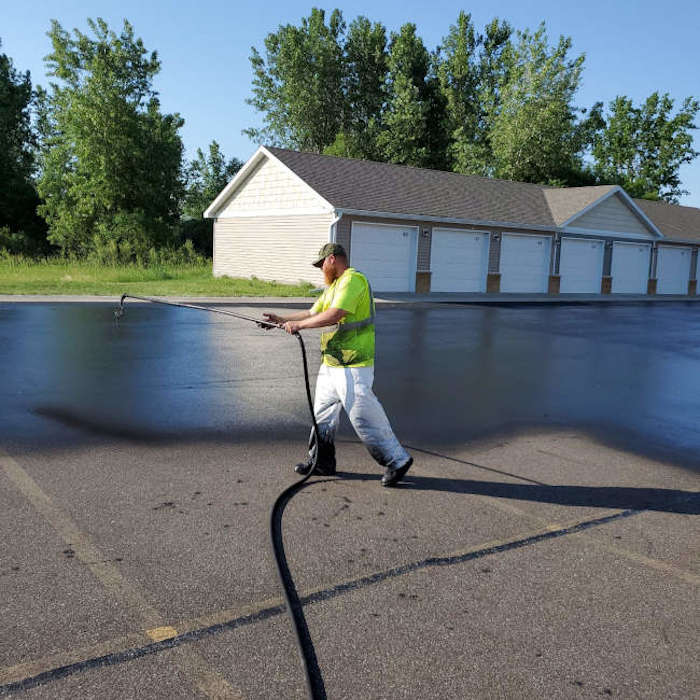Open the Keys of Asphalt Sealing: Optimizing Warm Mix Asphalt Longevity
Open the Keys of Asphalt Sealing: Optimizing Warm Mix Asphalt Longevity
Blog Article
Hot Mix Asphalt: A Lasting Remedy for Pavement
Hot Mix Asphalt (HMA) has arised as a leading lasting selection for sidewalk services, supplying a myriad of cutting-edge modern technologies and ecological benefits. As the demand for environment-friendly building techniques expands, discovering the subtleties of HMA's sustainability can offer beneficial understandings right into the future of pavement services.
Ecological Benefits of Warm Mix Asphalt

Additionally, Warm Mix Asphalt aids to minimize metropolitan heat island effects. Its dark color takes in sunshine, lowering the quantity of heat showed back right into the ambience contrasted to lighter-colored pavements. This can decrease ambient temperatures in city areas, lowering the need for a/c and inevitably minimizing power usage.
Furthermore, Hot Mix Asphalt adds to enhanced stormwater management. Its permeable nature enables water to recharge and infiltrate the pavement groundwater supplies, lowering runoff and the threat of flooding. These ecological benefits make Hot Mix Asphalt a sustainable option for paving roadways and freeways.
Energy Performance in HMA Production
Is power efficiency a critical factor in the production of Warm Mix Asphalt (HMA)? Absolutely. Energy plays a significant duty in the manufacturing of HMA, impacting both expense and ecological sustainability. One crucial aspect of energy effectiveness in HMA production is using warm mix asphalt (WMA) modern technologies (regrading). WMA enables the mixing and placement of asphalt at lower temperatures contrasted to traditional warm mix asphalt, resulting in reduced power usage throughout production. This process not only reduces gas use but likewise reduces greenhouse gas discharges, making it an extra eco-friendly option.
Moreover, advancements in plant technologies have actually caused even more energy-efficient HMA production processes. Modern plants are designed with functions like recycled asphalt sidewalk (RAP) processing capacities, effective heater systems, and boosted insulation, all adding to energy cost savings. By enhancing energy use in HMA production, the sector can reduce its carbon footprint while preserving high-quality sidewalk materials. Energy efficiency is, therefore, a critical factor to consider in ensuring the sustainability of Hot Mix Asphalt manufacturing.
Recyclability of Hot Mix Asphalt
The recyclability of Hot Mix Asphalt (HMA) is an essential aspect of its sustainability and long-lasting environmental impact. HMA is among one of the most recycled materials in the USA, with over 100 million lots of reclaimed asphalt pavement (RAP) being reused every year in new pavement building. Reusing HMA supplies a number of ecological advantages, such as minimizing the requirement for virgin materials, decreasing energy consumption during manufacturing, and reducing the amount of waste sent out to garbage dumps.
The procedure of reusing HMA entails milling the existing sidewalk, crushing it right into smaller sized items, and blending it with brand-new accumulation and asphalt binder to develop a recycled mix. This recycled mix can frequently do as well as or perhaps far better than standard HMA, while needing less resources and generating reduced greenhouse gas emissions. By incorporating RAP right into new pavement tasks, roadway companies can preserve natural deposits, minimize prices, and minimize the environmental impact of roadway building and upkeep activities. On the whole, the recyclability of HMA plays a significant duty in promoting lasting practices within the sidewalk market.

Long-Term Efficiency of HMA
Asphalt sidewalks demonstrate resilience and resilience over an extended period, showing the lasting performance of Hot Mix Asphalt (HMA) The longevity of HMA can be connected to its ability to stand up to hefty traffic loads, extreme weather condition problems, and the results of aging. Researches have shown that well-designed and appropriately built HMA pavements can last for twenty years or more with regular maintenance. The trick to maximizing the long-term performance of HMA hinges on using high-quality products, adhering to ideal methods in building and construction, and executing reliable maintenance techniques. Proper water drainage, regular assessments, and timely fixings are vital for preserving the structural integrity of HMA pavements gradually. In addition, improvements in HMA modern technology, such as the use of polymer-modified binders and warm mix asphalt, have actually further improved the toughness and longevity of HMA sidewalks. By prioritizing quality building and upkeep pop over to these guys techniques, HMA remains to confirm itself as a cost-effective and sustainable option for lasting sidewalk facilities.

HMA: Toughness and Sustainability
Demonstrating both sturdiness and sustainability, Warm Mix Asphalt (HMA) has actually ended up being a cornerstone in the construction of durable pavement facilities - hot mix asphalt. HMA's toughness stems from its capacity to stand up to heavy loads, harsh weather condition problems, and high web traffic volumes, making it a dependable choice for streets, freeways, and flight terminal paths. The make-up of HMA, which usually includes aggregates, binder, and filler, plays an essential function in enhancing its longevity and resistance to damage
Moreover, HMA's sustainability depends on its recyclability and energy-efficient production procedure. The capacity to reuse recovered asphalt pavement (RAP) in brand-new HMA mixtures decreases the demand for virgin products and reduces the ecological effect of pavement building and construction and maintenance. Furthermore, the energy effectiveness of creating HMA lies in its lower mixing temperature levels contrasted to other sidewalk products, bring about minimized power usage and greenhouse gas discharges.
Verdict
Finally, warm mix asphalt (HMA) supplies a sustainable option for sidewalk with its environmentally friendly attributes. HMA's recyclability, power effectiveness in production, and Web Site lasting durability make it an eco-friendly choice for roadway building and construction. By saving natural deposits, lowering waste, and decreasing greenhouse gas exhausts, HMA plays an important duty in promoting sustainability in infrastructure growth. Its capacity to mitigate metropolitan warmth island results additionally highlights its significance in developing durable and eco conscious sidewalk systems.
HMA is one of the most recycled materials in the United States, with over 100 million heaps of redeemed asphalt sidewalk (RAP) being reused annually in new pavement building.The procedure of reusing HMA includes crushing the existing sidewalk, squashing it right into smaller sized items, and mixing it with new aggregate and asphalt binder to develop a recycled mix.Asphalt pavements show durability and durability over an extensive period, mirroring the long-term efficiency of Warm Mix Asphalt (HMA) Additionally, advancements in HMA technology, such as the use of polymer-modified binders and cozy mix asphalt, have actually even more enhanced the resilience and durability of HMA sidewalks. The capacity to recycle reclaimed asphalt pavement (RAP) in brand-new HMA blends reduces the demand for virgin materials and decreases the ecological his explanation impact of sidewalk building and construction and upkeep.
Report this page